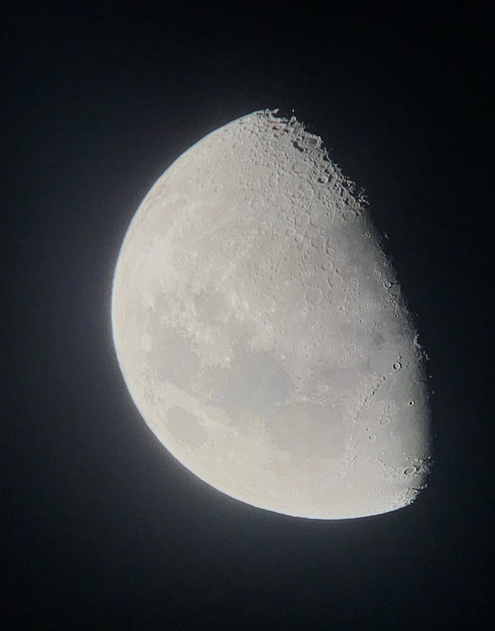AI-generated space photos may be doing more harm than good for boosting interest in science.
Monica’s moon photo: My own picture of the moon, taken in March 2023 from Montreal on my Iphone XS using a telescope.
In the 90s growing up, I saw lots of paintings of planets. While I didn’t always grasp that they were artistic representations, they piqued my curiosity.
For things we do not know how to imagine, visual representation can help us to understand them. But things can get complicated when fake photos of planets are being widely shared or AI is being used to modify photos of the moon without transparency or context.
Space photos may inspire exploration, but fake ones do more harm than good.
These days, people often get their news from social media, but don’t necessarily go out of their way to fact-check what they are reading or seeing. Fake photos can be spread quickly and create false impressions for viewers. When they are out of context, it is even harder to validate the info.
For instance, a fake picture of Saturn was shared on social media in 2019. Many people believed it was real. At first, I believed it.
The picture was shared thousands of times, across many different (unofficial) astronomy pages.
While these astronomy pages on social media may not be official or government fact-checked, they are very popular, which broadens the reach of any fake posts. Being on the internet, they can continue to be shared for years. The picture of Saturn continues to be shared today, five years later.
However, the pages can be good in other ways—such as generating an interest in science, which can fuel public involvement in supporting innovation, like space exploration.
In this article on mitigating disinformation on social media, the authors suggest that we “improve education and media literacy, as well as to prioritize quality over clicks and “likes.” This could be accomplished with a rating system (typical of what the broadcast media offers to guide viewers as to the suitability of their programs for various audiences).”
Perhaps at a time when science literacy is at risk from fake news, the risk is increased when AI images are not clearly identified. Therefore, fake photos should be labeled as such. We already know that AI is used in the scientific aspect of space exploration. Clearly identified AI images may help people to imagine space exploration and become intrigued by it.
However, when there isn’t transparency, the opposite can happen. In 2023, Samsung was accused of using AI to actually replace fuzzy parts in the photos its customers took of the moon with AI generated images of what the moon looked like. This didn’t make people curious; it made them mad.
In this 2021 article on scientific image forgery from the International Journal of Sociotechnology and Knowledge Development, Francisco Lopez-Cantos writes that “instead of facilitating the promotion of scientific culture, the production of attractive images that lack necessary explanations and their positioning as scientific portals that catalyze interest in knowledge may contribute to the mythification of science. This may also increase the distance between the research community and society. It is evident that images are key to the popularization of knowledge, as shown by a multitude of studies.”
When I attended an astronomy outing with Plateau Astro in Montreal, I was able to use a special telescope to take a picture of the moon, and I found that very inspiring. I would have been dismayed if I discovered that this included AI elements. It may have affected my future involvement in astronomy photography.
A frequent collaborator and colleague of Plateau Astro is Samer of Zenderfull, also based in Montreal. He regularly leads groups to photograph space and teaches workshops on the topic.
“I think it's important to do a separation between AI Generated photo and AI generated pieces of content,” he explained. “Many photographers use AI tools like Adobe Generative fill AI to fix some issues with photos, such as something blocking the foreground or maybe expanding a background. In my opinion, there is a fine limit of using such tools versus fully generating photos with AI.”
AI is already being used by scientists to help explore space. It sifts through large amounts of information at a faster than human speed. Examining patterns of galaxies, interpreting data, studying fluctuations in the temperature of the sun—all of these are great uses of AI.
However, there is some debate about AI utility in space photography. It’s currently being used to eliminate space junk that shows up on photos, because the trails from satellites affect the pictures taken from Earth. This provides clearer pictures, but it’s important that we know that things have been cleared out of the way. Otherwise, we risk ignoring the problem of space pollution because we no longer see it.
When photos can be manipulated, it’s possible it didn’t really happen. While there might be a case for using these photos for educational purposes, they need to be labelled as edited, so that we can know exactly what we are looking at, and maybe imagine something else that we cannot see yet.
When my elementary school self was looking through books with paintings of planets, even if I didn’t fully understand that they weren’t accurate, they still raised questions for me. In the current world, this sort of curiosity and skepticism is even more necessary.

By: Monica Walsh
Monica Walsh is an artist and writer from Newfoundland and Labrador. She is currently completing her graduate diploma in Communications Studies at Concordia University.
